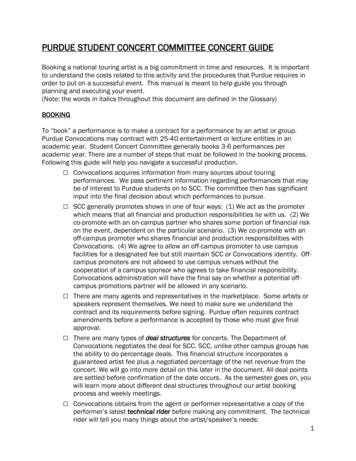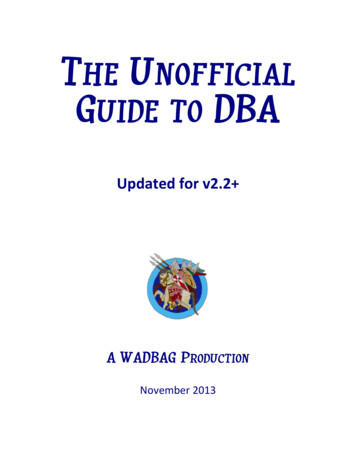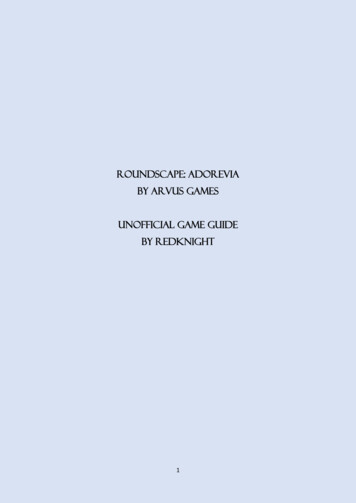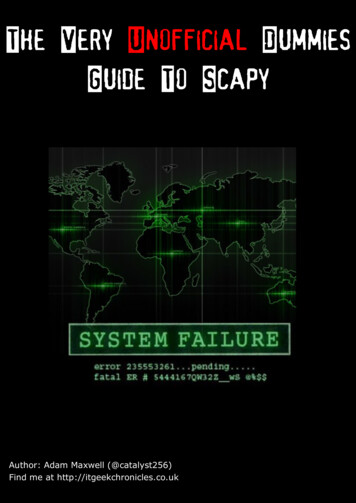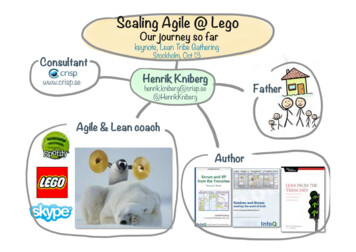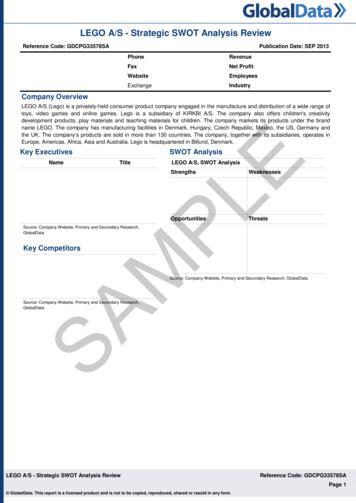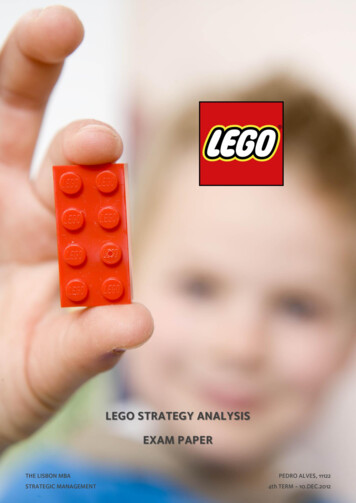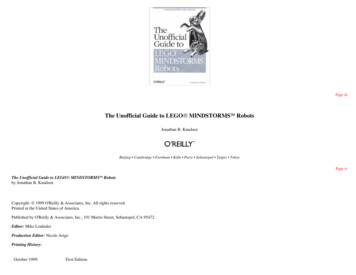
Transcription
Page iiiThe Unofficial Guide to LEGO MINDSTORMS RobotsJonathan B. KnudsenBeijing Cambridge Farnham Köln Paris Sebastopol Taipei TokyoPage ivThe Unofficial Guide to LEGO MINDSTORMS Robotsby Jonathan B. KnudsenCopyright: 1999 O'Reilly & Associates, Inc. All rights reserved.Printed in the United States of America.Published by O'Reilly & Associates, Inc., 101 Morris Street, Sebastopol, CA 95472.Editor: Mike LoukidesProduction Editor: Nicole ArigoPrinting History:October 1999:First Edition.
This book is published solely by O'Reilly & Associates, Inc., and its purpose is to enable you to creatively program LEGO MINDSTORMS brand robots. This book is not sponsored by TheLEGO Group.Nutshell Handbook, the Nutshell Handbook logo, and the O'Reilly logo are registered trademarks of O'Reilly & Associates, Inc. The association of the image of a mechanical toy rabbit with thetopic of LEGO MINDSTORMS robots is a trademark of O'Reilly & Associates, Inc. LEGO is a registered trademark of The LEGO Group. MINDSTORMS and Robotics InventionSystem are trademarks of The LEGO Group. All other trademarks, service marks, and the like are the property of their owners.Many of the designations used by manufacturers and sellers to distinguish their products are claimed as trademarks. Where those designations appear in this book, and O'Reilly & Associates, Inc.was aware of a trademark claim, the designations have been printed in caps or initial caps.While every precaution has been taken in the preparation of this book, the publisher assumes no responsibility for errors or omissions, or for damages resulting from the use of the informationcontained herein.ISBN: 1-56592-692-7[M][12/99]Page vFor Kristen who helps me reach my dreamsPage viiTable of ContentsPrefacexi1. Welcome to MINDSTORMS1What Is a Robot?2Mobile Robots2What Is MINDSTORMS?6What Now?11Online Resources112. Hank, the Bumper Tank14About the Building Instructions14Building Instructions16
A Simple Program25Wheels27Bumpers and Feelers31Gears31Multitasking36Online Resources373. Trusty, a Line Follower39Building Instructions40Some Tricky Programming44The Light Sensor48Idler Wheels50Using Two Light Sensors50Online Resources52Page viii4. Not Quite C53A Quick Start54RCX Software Architecture55NQC Overview58Trusty Revisited77Online Resources815. Minerva, a Robot with an ArmBuilding Instructions8283
Programming103Directional Transmission107Pulleys109Mechanical Design110Two Sensors, One Input112Where Am I?113Online Resources1156. pbFORTH116Replacement Firmware116pbFORTH Overview117About Forth121pbFORTH Words126An Expensive Thermometer137Minerva Revisited138Debugging142Online Resources1437. A Remote Control for Minerva145Two Heads Are Better Than One145The Allure of Telerobotics146Building Instructions147Programming the Remote Control151Programming Minerva154
Online Resources8. Using Spirit.ocx with Visual Basic157159You May Already Have Visual Basic159About Spirit.ocx160Calling Spirit.ocx Functions161Immediate and Delayed Gratification163Page ixPrograms, Tasks, and Subroutines164Tips165Retrieving the Datalog168Online Resources1719. RoboTag, a Game for Two Robots173Building Instructions174Subsumption Architecture179Online Resources18810. legOS189About legOS189Development Tools190Hello, legOS192Function Reference193New Brains for Hank204Development Tips211
Online Resources11. Make Your Own Sensors213216Mounting216Passive Sensors219Powered Sensors221Touch Multiplexer224Other Neat Ideas226What About Actuators?226Online Resources227A. Finding Parts and Programming Environments231B. A pbFORTH Downloader235C. Future Directions240Index243Page xiPrefaceThis is a book for people who build and program LEGO robots with the Robotics Invention System (RIS) set. This book is the answer to the question, "How can I push this thing as far as itwill go?" Once you've built a few robots and written a few programs, you'll probably be itching for more: more complex robots, more powerful programming environments, more sensors, andmore fun. This book will take you there.About This BookFor many of us, plastic LEGO bricks are the best toy money can buy. When I was five and broke my leg, a little LEGO set was the high point of my six-week convalescence. I grew up buildingspaceships and planetary rovers, wearing grooves in the ends of my fingernails from endlessly putting together and taking apart my creations. In high school, I shifted into the TECHNIC productline—what could be better than cars with real shifting and pistons that worked?In the Fall of 1998, The LEGO Group released the Robotics Invention System (RIS), a set that was part of a new product line called MINDSTORMS . This set entered the world like a lightningbolt—finally, the chance to make LEGO models that moved, sensed, and thought! The LEGO Group made 80,000 of these sets in 1998 and sold every one. Although The LEGO Group wasaiming for young adults, 11 and older, the RIS has also hypnotized many people in their 20s, 30s, and beyond.
A vibrant, inventive online community sprang up around MINDSTORMS robots. In some ways, this book is an introduction to the most important developments in that community—alternateprogramming environments and advanced building techniques. But this book goes farther than that, painting a backdrop of the theories and practices of mobile robotics.Page xiiBuilding and programming robots is exhilarating. It's fun to build something that moves and thinks, in a sense; at the same time, you're learning a lot about how things work, mechanically, andhow to write programs that can deal with the real world. This book is designed to take you to the next level of building and programming, all in the spirit of fun and learning.This book's chapters come in two basic flavors. Five chapters have robot projects, complete with building instructions and programs. Four chapters describe various programming environments forLEGO MINDSTORMS robots, including code examples and debugging tips. The first and last chapters don't fit in either category.Here's a description of each chapter in this book:Chapter 1, Robotics and MINDSTORMS, introduces the field of mobile robotics and describes how the LEGO MINDSTORMS Robotic Invention System fits in the larger picture of the field.Chapter 2, Hank, the Bumper Tank, is the first building project—a tank-style robot that avoids obstacles in its path. This chapter discusses basic mechanical features like gears and bumpers.Chapter 3, Trusty, a Line Follower, covers a slightly trickier robot—a line-follower. It uses a light sensor to follow a black line on the floor.Chapter 4, Not Quite C, introduces the Not Quite C (NQC) language. NQC is an excellent environment for programming robots. The chapter includes descriptions of NQC's functions as well asmany examples.Chapter 5, Minerva, a Robot with an Arm, contains another building project—by far the most complex robot in the book. You'll learn about directional transmissions and other neat stuff.Chapter 6, pbFORTH, discusses an innovative programming environment based on a language called Forth.Chapter 7, A Remote Control for Minerva, is another project-based chapter. Using a second robot kit, you can build a remote control for the robot from Chapter 5.Chapter 8, Using Spirit.ocx with Visual Basic, talks about how to control and program your robots using Microsoft's Visual Basic.Chapter 9, RoboTag, a Game for Two Robots, shows how to create a pair of robots that play tag.Chapter 10, legOS, discusses legOS, a programming environment that enables you to program your robots with C, C , or assembly code.Chapter 11, Make Your Own Sensors, describes how you can build sensors for your robots easily and inexpensively.Page xiiiAppendix A, Finding Parts and Programming Environments, describes various parts you can get to expand your RIS set and where to find them. It also includes a summary of the programmingenvironments that are available for RIS.Appendix B, A pbFORTH Downloader, contains the source code for a program that downloads Forth code to your robots. It's a supplement to Chapter 6.Appendix C, Future Directions, describes some interesting emerging technologies related to LEGO robots. These are ideas or projects that weren't fully baked as this book went to press.About the ExamplesVersionsThis book covers a handful of rapidly evolving technologies. The versions used in this book are as follows:RCXVersion 1.0NQCVersion 2.0b1
pbFORTHVersion 1.0.7legOSThe March 30, 1999 build, a patched version of 0.1.7DownloadingAll of the examples in this book can be downloaded from http://www.oreilly.com/catalog/lmstorms/. This site also provides a listing of the "Online Resources" that appear at the end of eachchapter.Font ConventionsConstant width is used for: Function and subroutine name Source code Example command-line sessions—the input you type is shown in boldfacePage xivItalic is used for: Pathnames and filenames New terms where they are defined Internet addresses, such as domain names and URLsBoldface is used for the names of buttons.This is a note with information that supplements the text.This is a warning with a cautionary message for the reader.Request for CommentsIf you find typos, inaccuracies, or bugs, please let us know. You can reach O'Reilly by mail, telephone, fax, or email:O'Reilly & Associates, Inc.101 Morris StreetSebastopol, CA 95472(800) 998-9938 (in the U.S. or Canada)(707) 829-0515 (international or local)(707) 829-0104 (fax)bookquestions@oreilly.comPlease let us know what we can do to make the book more helpful to you. We take your comments seriously, and will do whatever we can to make this book as useful as it can be.
AcknowledgmentsThis book is the result of a crazy idea I had in mid-1998, when I first heard that the Robotics Invention System was coming. LEGO robots sounded like something O'Reilly readers would like toplay with—why not write a book about them? I'd like to thank Mike Loukides and Tim O'Reilly for having the vision to believe in this book. Thanks to Mike, again, for excellent help andfeedback.Page xvI'd like to thank my parents for buying me LEGO sets when I was a kid. Did you ever expect something like this?Many thanks go to my wife, Kristen, for helping to create this book. She first suggested its project-oriented organization; she gave me excellent feedback on many of its chapters; she got meRolyKits to help organize my pieces; she is able to keep a straight face when we tell people I'm writing a book about LEGO robots; she stayed up late nights helping me finish the book.I'm grateful to my daughter, Daphne, who finally believes that building LEGO robots is part of my job. ''Want to see Daddy," she said one day. Kristen explained, "No, no, sweetheart, Daddy'sworking right now." With tears in her eyes, Daphne said, "Daddy's not working. Daddy play LEGOs." Someday, I promise, I'll let Daphne play with the whole set, not just the bendy purple things.And thanks to my sons, Luke and Andrew, just for being great guys. You can build robots someday too, if you wish.The building instructions in this book were a special challenge. I first sketched out the building instructions with photos from a digital camera. Once these were finished, Kristen took over 475photographs with a regular camera. We selected the best and sent them off to the O'Reilly illustration department. These photographs were scanned in and meticulously touched up, cropped,edited, and manipulated to produce the instructions that you see in the book. I owe many thanks to Rob Romano for his hard work on these instructions.This book has had an excellent set of technical reviewers. Ralph Hempel, Todd Lehman, Russel Nelson, Suzanne Rich, John Tamplin, ActivMedia Robotics (http://www.activrobots.com/), andBen Williamson provided insightful and authoritative feedback on a draft of this book. Thanks also to Stephan Somogyi for encouraging me to include more information about using a Macintoshwith MINDSTORMS.Page 11Welcome to MINDSTORMSIn this chapter: What Is a Robot? Mobile Robots What Is MINDSTORMS? What Now? Online Resources
This is a book about creating robots with the LEGO MINDSTORMS Robotic Invention System (RIS) . If you've always dreamed of building and programming your own robots, this is yourbig chance—the RIS set makes it easy to get started. There are a lot of enthusiastic RIS owners out there already: other people have built robots that pick up empty soda cans; robots that seek light;robots that play tag; walking robots with two, four, six, or even eight legs; robots that can be controlled over the Internet; working computer peripherals like a plotter and an optical scanner; androbots that simulate a Tsunami and a tornado. You can build anything you can imaging. RIS gives you a chance to breathe life into LEGO creations, making them move and respond to theirsurroundings. You can create a tank that scurries into the dark, or a monorail car that traverses your living room on a string. You can create robots that hop, walk, and drive around with a mind oftheir own.Furthermore, by owning the RIS set, you become part of a worldwide community of enthusiasts. The RIS set is a common ground for building robots; if you build something cool, other peoplewill be able to build it too. Similarly, you can build and modify other people's creations. LEGO bricks, therefore, are a kind of lingua franca for mechanical design.You have many options when it comes to building and programming robots. LEGO bricks, of course, can be assembled in many different ways. Part of this book is about building robots; itincludes five projects that you can build yourself. But you also have lots of options for programming your robot. Aside from the "official" software that comes with RIS, the inventiveMINDSTORMS community Internet links to pictures of some of these robots are included in the "Online Resources" section at the end of this chapter.P
bolt—finally, the chance to make LEGO models that moved, sensed, and thought! The LEGO Group made 80,000 of these sets in 1998 and sold every one. Although The LEGO Group was aiming for young adults, 11 and older, the RIS has also hypnotized many people in their 20s, 30s, and beyond. A vibrant, inventive online community sprang up around MINDSTORMS robots. In some ways, this book is an .
